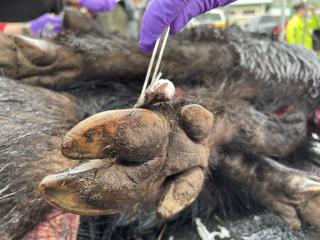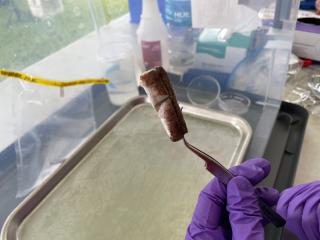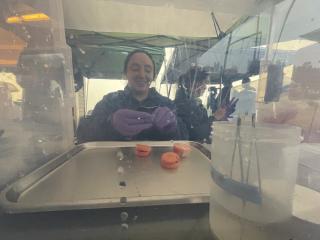Forest Service, Hawaiʻi pig hunters partner up against Rapid ʻŌhiʻa Death
HAWAIʻI — Forest Service researchers and partners, including Hawaiʻi Island pig hunters, are collaborating to study the spread of Rapid ʻŌhiʻa Death. ROD is a devastating tree disease caused by Ceratocystis fungi that attack the ʻōhiʻa, Metrosideros polymorpha, Hawaii's most important native tree. To better understand the role wild pigs may have in spreading ROD, USDA Forest Service researchers work with Keiki of Da ʻĀina, also known as KOA, to coordinate and enable the sampling of wild pigs caught in different places across the island.
“One way the ROD fungi can spread is through the movement of soil and mud containing the spores,” said Dr. Kealoha Kinney, a Forest Service Research ecologist. “Along with humans, one potential transporter of ROD is Hawaii’s wild pig population. As pigs seek food by rooting in the ground and traveling within the forests, they may be picking up Ceratocystis spores from the soil and bringing them to new places. Taking a closer look at the behavior, movement and organic materials on the bodies of wild pigs can help improve our understanding of Rapid ʻŌhiʻa Death.”

Pig hunting provides an important window into understanding wild pigs on the landscape. KOA is a non-profit dedicated to perpetuating Hawaiian culture and hosts an annual pig hunting tournament for the Hawaiʻi Island community. KOA's founder, Nakoa Pabre, and Dr. Kinney realized that the tournament's weigh-in was an opportunity for researchers and hunters to exchange knowledge about ROD and wild pigs. Hunters have expert knowledge of Hawaiian forests, acquired over generations. They make detailed observations of the pigs and the environments they use. Hawaiian hunting traditions are intertwined with protecting the health of Hawaii’s forests and the many of the resources hunters and their families depend upon. KOA and the Forest Service share the same overarching goal of “caring for the land and serving people.”
This spring was KOA’s 10th annual pig hunting tournament and the third time that Forest Service scientists and partners collected samples from the tournament’s caught pigs. Twenty-six hunting teams brought 48 pigs to the weigh-in and samples were collected from each pig. The sampling team included the Forest Service Pacific Southwest Research Station, Akaka Foundation for Tropical Forests, National Ecological Observatory Network, and the University of Wisconsin. They swabbed the pigs' skin, collected hair samples, estimated age and asked hunters for the pigs’ general locations. The skin swabs are tested for Ceratocystis fungi while the hair samples are analyzed to understand the pigs’ diet.

Information gathered from the samples and knowledge shared by the hunters will help create a clearer picture of wild pigs’ relationship with Rapid ʻŌhiʻa Death, as well as the role hunters play in forest health. For this research the support of hunters, KOA, and partnering organizations make it possible for scientists to collect data quickly from a large number of pigs from across the island and share back information learned from previous tournaments.
The Forest Service’s Pacific Southwest Research station looks forward to continuing the cooperative relationship with Keiki of Da ‘Āina and sharing a growing understanding of both Rapid ʻŌhiʻa Death and wild pigs with Hawaii's hunting community.


